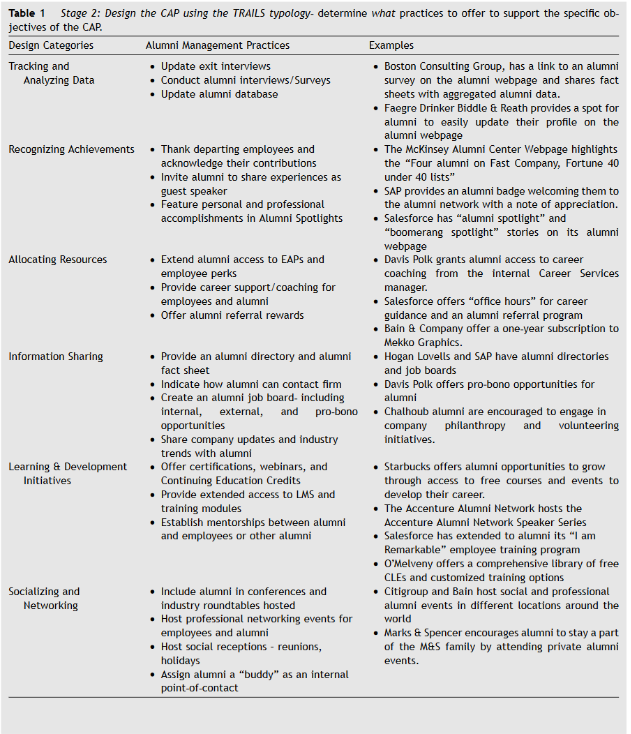The Complete Guide to Corporate Alumni Event Planning in 2025
This expert guide equips you with everything you need to know to create vibrant and engaging events that elevate your corporate alumni program.
Read more
In this new whitepaper, Professors Alison Dachner and Erin Makarius discuss how to systematically design your Corporate Alumni Program for success.
Amidst the “Great Resignation,” companies are finally starting to appreciate the value corporate alumni can provide for “talent acquisition, brand reputation, knowledge management and as clients or customers.”

Organizations today are facing increasing amounts of turnover and evolving labor markets. When employees leave they become corporate alumni, which initial research suggests are an important and valuable part of an organization’s network. Corporate alumni can provide value as brand ambassadors, a source of employee referral, as a return employee (i.e. boomerang), or through knowledge sharing.
One way to establish a strong network of alumni and achieve some of these benefits is to establish a corporate alumni program (CAP). Although CAPs are increasingly being recognized as beneficial for organizations, little is known about how to systematically design and implement these programs to enhance the likelihood of success. In this article, we utilize instructional systems design processes to offer guidance for how to strategically develop CAPs. We analyze existing programs to highlight common elements and use this research as a basis for creating the TRAILS typology, a way to designate practices for CAP implementation. We also suggest ways to evaluate and determine whether these programs are successful.
First, you must determine the if, why and how. If a CAP is right for your organization, why your organization may need a CAP, and how it fits in your organization’s overall strategy and objectives. Start with an organizational and personnel analysis, align current HR processes with your alumni management strategy, and get buy-in from management and employees. It is critical that the CAP is designed with the strategic goals and visions of the organization in mind.

What is the TRAILS typology?
Download table here.
Once you have your objectives for the CAP and determined what form the CAP will take, it is time to roll up your sleeves and get to the how of the program; more specifically, how will it be integrated into your current processes and systems. This is the phase where the CAP starts to take shape.
It is important to identify where the CAP fits in the organization’s structure, which is typically determined by the goals and objectives of the program. If the organization wants to encourage boomerang hires, then the CAP should be within HR. If the goal is to foster community engagement: marketing and communications. Or, in some cases, if you want to use alumni as a means to maintain connections for business opportunities, perhaps sales and business development is the best department to manage the CAP.
Figure out who will be responsible for the CAP. Having at least one dedicated individual, or a dedicated individual per major geography, as the champion of the program will ensure the program is maintained and executed.
Lastly, you have to plan for the future. Define your brand, how you will communicate, and think through the process of onboarding alumni from the beginning stages to when you’re multiple years into your program. A successful alumni program will continue to create engaging content for the life of the CAP to ensure the alumni community remains vibrant and interesting to keep alumni coming back.
“…where a CAP fits in the organization is less important than having a dedicated employee (with executive support) who can make connections across all areas of business and build community among a diverse group of people.”
Time to get the CAP out into the world and invite alumni to be members of the program. First, determine when you will introduce employees to the CAP, and clearly message the value proposition. There are multiple touch points available to offer to alumni in order to bring them into the program. Come up with the touch points that make the most sense for your organization. Second, define who will be part of your alumni program. Every company defines alumni slightly differently and therefore has different rules for who will be invited, and who might be included or excluded from participating. Alison and Erin recommend an all-inclusive alumni program as it can be tricky to “cherry pick alumni,” and you never know where an alumni might go and how that could mutually benefit both organization and alumni.
Lastly, measure and measure again. Most organizations begin this process with increased ROI in mind. So, how will you measure the ROI of the program. What other metrics are important to your people strategy within the organization. Understanding from the very beginning how you will judge success of the CAP is critical. There are many metrics to monitor: (1) employee and alumni satisfaction, (2) employee and alumni engagement behaviors, and (3) and business driver results such as talent acquisition. The ways to measure your program are endless, so make sure the metrics you care about align with your initial strategic objectives.
Retention, while important, is not the only strategy that evolving companies can pursue. As mobility increases for the workforce, companies must broaden their vision of what is considered under the umbrella of employee lifecycle management to include offboarding employees. Alumni relationship management, if handled properly through the offboarding process and beyond, can be a boon to your talent management strategy and provide a pathway back for your best former employees.
Download the white paper for expert insights on how to systematically design corporate alumni programs. For more information on how an alumni program can work for you, get in touch with the EnterpriseAlumni team today.
Source: Follow the trails: A path to systematically designing corporate alumni programs; A.M. Dachner and E. Makarius, Organizational Dynamics
NEWSLETTER


This expert guide equips you with everything you need to know to create vibrant and engaging events that elevate your corporate alumni program.
Read moreDecember 27, 2024
Use these 5 best practices to ensure your alumni network is bringing the most value to both you and your former employees.
Read moreSeptember 8, 2023
The former Managing Director in Citibank’s Corporate and Investment Bank shares his experiences building the company’s EMEA alumni program.
Read moreJuly 19, 2023
Build new revenue streams, save on recruitment and enhance your employer brand, all through the power of alumni.